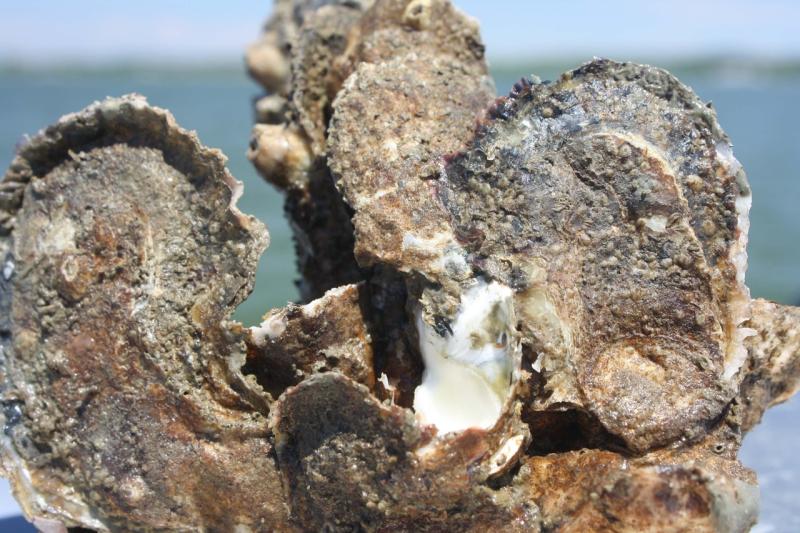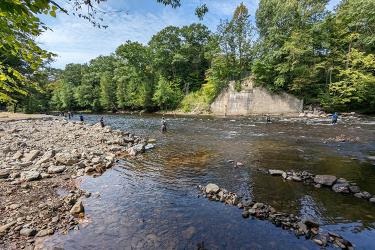With a 64,000 square mile watershed that more than 18 million people in parts of Delaware, Maryland, Pennsylvania, New York, Virginia, West Virginia, and all of Washington, D.C. call home, the Chesapeake Bay is indeed a complex ecosystem. Relative to its size, what happens on land has a tremendous impact on the Bay—and therefore on the habitat it provides for all the animals who live there. The Chesapeake’s watershed land-to-water ratio is 14:1, the largest of any coastal water body in the world.
The Chesapeake Bay faces many challenges: excess nutrients and sediment that pollute streams, rivers, and the Bay itself; invasive species that crowd out native plants and animals; changing weather and climate patterns that affect the land, air, and water; and complex decisions regarding competing uses, including fishery and habitat management.

One of the ways NOAA supports the Chesapeake Bay Program’s oyster restoration goal is by providing habitat data acquisition and analysis to help site oyster restoration projects and to monitor their progress.
To identify and implement solutions, the Chesapeake Bay Program was formed in 1983. The dozens of partners in the Chesapeake Bay Program include federal and state agencies, local governments, nonprofit organizations, and academic institutions. Each organization brings unique knowledge, capabilities, and perspectives to this tremendous partnership. NOAA is represented in the Chesapeake Bay Program by the NOAA Chesapeake Bay Office, a division of NOAA’s Office of Habitat Conservation.
In 2014, Chesapeake Bay Program federal and state partners signed the Chesapeake Bay Watershed Agreement, including ten goals that will support the restoration and protection of the Bay watershed. NOAA efforts focus on the following goals and principles:
- Sustainable Fisheries Goal: NOAA is the federal lead for interjurisdictional fisheries management, providing scientific support for decision-making and convening state fisheries managers to discuss key resource issues. The Sustainable Fisheries Goal Implementation Team’s Chesapeake Bay Stock Assessment Committee, which includes scientists and resource managers from around the Bay watershed, analyze data to develop the annual Blue Crab Advisory Report.
- Vital Habitats Goal: NOAA has identified the Choptank River watershed as a Habitat Focus Area, bringing coordinated funding and support to advance oyster and other habitat restoration efforts in the watershed as well as to work with the community and to enhance scientific knowledge about the watershed.
- Environmental Literacy Goal: NOAA is the federal lead for K-12 education in the Chesapeake Bay Program partnership, building capacity to support hands-on outdoor education and working to embed NOAA content in schools. Recently, the Education Workgroup released the Educator’s Guide to the Meaningful Watershed Educational Experience to help give educators tools they need to teach about the Bay ecosystem.
- Climate Resiliency Goal: NOAA is the lead for this goal, working with a mix of federal, state, local, and nongovernmental partners to monitor and assess trends and impacts and to implement on-the-ground projects to build resilience to environmental change.
- Monitoring Principle: NOAA maintains the NOAA Chesapeake Bay Interpretive Buoy System, an important monitoring system for understanding and predicting changes in the Bay ecosystem.

NOAA CBIBS buoys observe data that scientists can use to track changes to the Chesapeake Bay over time.
How is the effort going?
With so many challenges and so many people living in the watershed, the Chesapeake Bay Program didn’t expect an overnight turnaround in the state of the Bay. In fact, many of the goals set in the 2014 Watershed Agreement include milestones out to the year 2025. However, the work is already showing promise, a recent Chesapeake Bay Report Card shows solid signs of progress toward cleaner water and healthier habitat, which benefit humans and other species alike.



